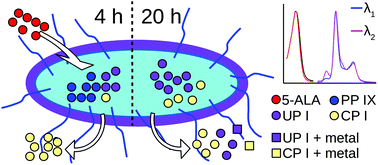Sensitization of Salmonella enterica with 5-aminolevulinic acid-induced endogenous porphyrins: a spectroscopic study†
Abstract
Photodynamic therapy (PDT) of bacterial strains presents an attractive potential alternative to antibiotic therapies in search of the solution for the chemoresistance problem. The efficacy of the treatment is dependent on the interaction of photochemically active substances called photosensitizers (PSs) with the bacterial cell wall or their intracellular accumulation. In addition to exogenous PSs, other molecules such as 5-aminolevulinic acid (5-ALA), a natural precursor of heme, are gaining interest. When provided exogenously to cells, 5-ALA uptake results in the overproduction of various photoactive porphyrins. The pattern of their intracellular accumulation and release to the surroundings depends on incubation conditions such as the applied 5-ALA concentration, cell density and incubation duration. The detection of endogenously synthesized porphyrins in samples of Salmonella enterica cells and supernatants was accomplished after 4 h and 20 h incubation periods by means of fluorescence spectroscopy. The relative proportions of different types of porphyrins were assessed by modeling the registered spectra with the fluorescence spectra of standard porphyrins. After the shorter incubation period, the dominant porphyrins in the supernatant medium were coproporphyrins. The longer incubation period shifted the relative proportion of intracellular porphyrins from protoporphyrin IX towards water-soluble porphyrins such as uroporphyrin I, which interfered with additional by-products. The time-dependent changes in compositions of both intracellular and extracellular porphyrins imply that 5-ALA-induced sensitization might have triggered a complex protective mechanism of bacterial cells. Thus, identification and evaluation of the relative amounts of porphyrins, which accumulate in bacterial cells and are extruded outside after different time periods, could provide access to valuable information, working towards more efficient applications of 5-ALA-based antibacterial PDT.



 Please wait while we load your content...
Please wait while we load your content...